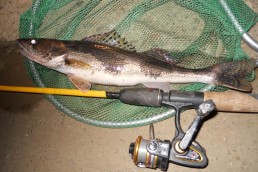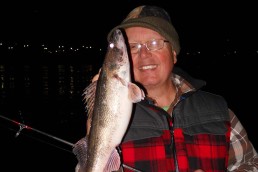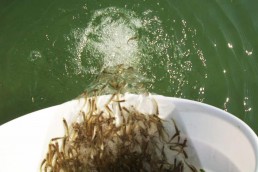Heatin’ Up Cold Saugers and ‘Eyes on the Ohio
Man it was cold.
After retrieving a shiner from the minnow bucket, the wind and chilly January temperatures quickly numbed my fingers. My partner and I were after some Ohio River saugers and ‘eyes.
We were fishing the Pike Island locks and dam. I cast out a head-hooked minnow on a Carolina rig. The eddy’s current edge slowly rolled the 1-ounce egg slip sinker along the bottom. When it stopped moving, a telltale “tap, tap” signaled a hit. I set the hook, and after a spirited tussle, the 14-inch sauger was landed.
Not to be out done, my partner hooked a nice saugeye. His rig was nothing more than a bell sinker on the end of the line, preceded by two #4 Eagle Claw rotating snelled hooks. The hooks were spaced 12 inches apart and baited with river shiners. He liked this rig because he simply cast it out and watched the fishing rod’s limber tip for a hit. While waiting, his hands were inside his coat’s warm pockets.
The action was pretty good and kept us fairly warm. Later, we switched over to 1/8-ounce jigs and twister tails and swam them just above the bottom. White and chartreuse tails worked the best. The artificials were a welcome change, because we no longer had wet fingers from handling minnows.
After several hours of fishing, we left with a nice stringer of saugers, saugeyes, and one 3-pound walleye. Best of all, we had the whole fishing platform to ourselves.
Saugers and Ohio River ‘eyes action are mainly done by the locals. Depending on water flow and cooling temperatures, the action begins around mid- to late September, with the majority of anglers fishing for ‘eyes and saugers during nice-weather days in mid-October and November. Bad weather during the colder months may discourage anglers from going forth. However, there still are fish to be caught at this time.
One person who knew about saugers, saugeyes, and walleyes on the Ohio River was Harold Legg. Harold was a wizard at catching these toothy critters. He recently passed away. He consistently caught numbers of saugers and ‘eyes for many years.
“I fish the eddies behind the dam,” Harold said once. “When fishing in the daytime, I like the water to be up above normal pool with a little color in it. However, I don’t want it to be muddy. I tend to fish more at night because we seem to do better after dark.
Whether fishing in daylight or moonlight, Legg basically used the same techniques. This usually involved 1/16-ounce lead head jigs. Hot pink was his favorite jig color followed by chartreuse. He baited them either with a head-hooked minnow or a 2- inch twister tail. Pearl was his favorite tail color. When the conditions called for a heavier jig, he switched to a 1/8-ounce model with a size 2 hook and a 3-inch twisty tail.
During daylight, he’d cast the bait as far out as possible. He let it sink to the bottom, and usually started by swimming the jig just above the river’s floor. If that didn’t work, he swam it along the bottom, and then stopped the retrieve to hop it, before swimming it again.
Harold swam a jig and twisty tail more than he swam a minnow. He felt the minnow by itself attracted fish. Therefore, he swam a jig and minnow, but also allowed it to sit on the bottom for periods of time. He fan casted areas until fish were found. Once located, he kept casting to the same spot until they moved.
At night, he used the same jig combination. However, he tended to fish the jig higher up. Harold started by making a long first cast. To determine water depth, he counted the jig down as it fell to the bottom. On the next cast, he started retrieving when the lure was half way down. He used a steady retrieve with the jig and twister tail. He would systematically fan cast the entire area. If nothing hit at this depth, he counted it down deeper, and again cast to all reachable spots. At times, he sped up the retrieve as soon as it hit the water and slowed it down.
At times, he used another effective retrieve: He started with the jig sinking half way to the river floor. Next, he cranked it fairly fast for several feet, then slowed it down, then reeled faster before slowing it down. He did this all the way back to the shore.
Harold kept changing speeds, depths and locations until the fish and correct retrieve were found. He kept pounding the productive spot until they quit. Before leaving the hot area he changed the jig’s depths, retrieve speed, etc.
“One of my best nights was New Year’s,” Legg said. “We started fishing at 2 a.m., and you almost had to hide your bait to keep the fish off. The fish were really on the feed. It was cold, but when you are catching fish one right after the other, the cold doesn’t matter.”
During the winter months some crazy boat fishermen, myself included, catch saugers and ‘eyes in eddies downstream from the locks and dams. Be certain not to enter areas where fishing boats are prohibited.
We like to slowly work the edge of an eddy with the electric trolling motor. The most common rig uses a 1/8- or 1/4-ounce jig tipped with a head-hooked minnow. Make certain that the jig is just skipping over the rocks. Some days they like jigs with glow paint. At times, white and chartreuse Fuzzy Grubs tipped with minnows are also effective. Gulp Minnow in Chartreuse and Shiner colors can be dynamite at times. Besides the standard retrieves, sometimes barely crawl the Gulp Minnow along the bottom. When a fish hits, make certain to hover over the spot, because these fish can be tightly schooled.
In heavier currents, try a 1/2- or 1-ounce Hopkins Spoon or a Swedish Pimple jigging spoon. Head-hook two or even three minnows on the treble hooks. Gently flip your wrist to keep the fluttering lure just above the bottom. The flashing spoon along with the multiple minnows is tough for big saugers, walleyes and saugeyes to resist.
In these cold-water conditions, I wear a Mustang Survival suit. Not only is it super warm, but it also floats and delays hypothermia. I have never fallen into frigid waters with it, but when challenging the elements it’s a good item to wear.
This year when looking for some hot action during cold-water conditions, try heatin’ up some Ohio River saugers and ‘eyes.
For Ohio River locks and dam locations:
Wildlife District 4 (740-589-9930 or Wildlife District 5 (937-372-9261) and ask for the Ohio River Fishing Guide publication.
MWO
SHARE THIS POST
Did you enjoy this post?
You can be among the first to get the latest info on where to go, what to use and how to use it!
Paul Liikala
Paul Liikala was raised on a farm which was close to Lake Erie and the Grand River. He was fortunate to have parents who nurtured his love for the outdoors. His only hope is that his writings show the love and admiration that he has for the Great Outdoors and its participants.




